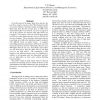Free Online Productivity Tools
i2Speak
i2Symbol
i2OCR
iTex2Img
iWeb2Print
iWeb2Shot
i2Type
iPdf2Split
iPdf2Merge
i2Bopomofo
i2Arabic
i2Style
i2Image
i2PDF
iLatex2Rtf
Sci2ools
HICSS
2000
IEEE
2000
IEEE
Strategic Behavior in Spot Markets for Electricity when Load is Stochastic
In the first part of the paper, daily price data for the past three summer seasons in the PJM wholesale market are used to estimate a stochastic regime switching model. These data show that the average price in 1999, when market-based offers were allowed, was twice as high as it was in the previous two seasons when offers had to be cost-based. The primary cause was that the price spikes in 1999 were much higher than they were in 1997-98, but not more frequent. The second part of the paper derives an optimum set of offers for individual suppliers endowed with different levels of market power. A supplier controlling generation equivalent to 20% of the expected load in the market is shown to submit offers that are up to 80% higher than the true cost. Nevertheless, these offers are still much lower than the offers that set the high prices in the PJM market. The explanation is that suppliers with sufficient market power are indifferent to whether or not marginal units are dispatched, and t...
| Added | 31 Jul 2010 |
| Updated | 31 Jul 2010 |
| Type | Conference |
| Year | 2000 |
| Where | HICSS |
| Authors | Timothy Mount |
Comments (0)

